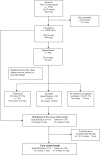A case control study of the relationship between persistent serum creatine kinase elevation and polyneuropathy
- PMID: 38879579
- PMCID: PMC11180140
- DOI: 10.1038/s41598-024-64555-x
A case control study of the relationship between persistent serum creatine kinase elevation and polyneuropathy
Abstract
Creatine kinase (CK) has been associated with neuropathy, but the mechanisms are uncertain. We hypothesized that peripheral nerve function is impaired in subjects with persistent CK elevation (hyperCKemia) compared to age- and sex matched controls in a general population. The participants were recruited from the population based Tromsø study in Norway. Neuropathy impairment score (NIS), nerve conduction studies (NCS) and electromyography (EMG) in subjects with persistent hyperCKemia (n = 113; 51 men, 62 women) and controls (n = 128; 61 men, 67 women) were performed. The hyperCKemia group had higher NIS score than the controls (p = 0.050). NCS of the tibial nerve showed decreased compound motor action potential amplitude (p < 0.001), decreased motor conduction velocity (p < 0.001) and increased F-wave latency (p = 0.044). Also, reduced sensory amplitudes of the median, ulnar, and sural nerves were found. EMG showed significantly increased average motor unit potential amplitude in all examined muscles. CK correlated positively with glycated hemoglobin and non-fasting glucose in the hyperCKemia group, although not when controlled for covariates. The length dependent polyneuropathy demonstrated in the hyperCKemia group is unexplained, but CK leakage and involvement of glucose metabolism are speculated on.
Keywords: Creatine kinase; Electromyography; HyperCKemia; Nerve conduction study; Polyneuropathy.
© 2024. The Author(s).
Conflict of interest statement
The authors declare no competing interests.
Figures
Similar articles
-
[Evaluation of polyneuropathy severity in chronic renal failure patients on continuous ambulatory peritoneal dialysis or on maintenance hemodialysis].Przegl Lek. 2007;64(6):423-30. Przegl Lek. 2007. PMID: 18159852 Clinical Trial. Polish.
-
Variation of serum creatine kinase (CK) levels and prevalence of persistent hyperCKemia in a Norwegian normal population. The Tromsø Study.Neuromuscul Disord. 2011 Jul;21(7):494-500. doi: 10.1016/j.nmd.2011.04.007. Epub 2011 May 17. Neuromuscul Disord. 2011. PMID: 21592795
-
Single-fiber electromyography in hyperCKemia: the value of fiber density.Neurol Sci. 2012 Aug;33(4):819-24. doi: 10.1007/s10072-011-0836-5. Epub 2011 Nov 9. Neurol Sci. 2012. PMID: 22068218
-
Approach to the Patient With HyperCKemia.Continuum (Minneap Minn). 2016 Dec;22(6, Muscle and Neuromuscular Junction Disorders):1803-1814. doi: 10.1212/01.CON.0000511069.68640.39. Continuum (Minneap Minn). 2016. PMID: 27922494 Review.
-
Performance analysis of noninvasive electrophysiological methods for the assessment of diabetic sensorimotor polyneuropathy in clinical research: a systematic review and meta-analysis with trial sequential analysis.Sci Rep. 2020 Dec 10;10(1):21770. doi: 10.1038/s41598-020-78787-0. Sci Rep. 2020. PMID: 33303857 Free PMC article.
References
MeSH terms
Substances
LinkOut - more resources
Full Text Sources
Research Materials


